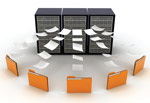
Q & A From the Top: Daniel Cremins
The increasing popularity of IP video surveillance has sparked the development of several new solutions to guard against potential video loss due to network outages or server failures. We wanted to know more about "fail-safe" recording options for IP video, so we sat down with Daniel Cremins, March Networks' product marketing manager for edge devices.
Q. What options exist today to ensure redundancy when designing IP video networks?
A. RAID devices and server mirroring are two options commonly used to ensure redundancy in an IP video system. System designers also are able to take advantage of solutions at the edge by using SD cards in cameras and encoders or networked attached storage devices to record video during a network outage or server failure.
Q. How does redundancy affect system design and the overall system cost?
A. RAID devices and server mirroring are great solutions, but they are expensive, not only in terms of the cost of the hardware but also the requirement for duplicate licensed software. SD cards and NAS devices, on the other hand, are both inexpensive and readily available in the consumer marketplace. You can buy an SD card for $10 or go to an electronics shop and pick up an inexpensive NAS device.
Q. We've heard a lot of buzz recently about a capability called shadow archiving. What is shadow archiving, and how does it work?
A. Shadow archiving architecture takes advantage of redundant storage at the edge—SD cards and NAS devices—and incorporates a number of other features that allow you to access recorded video from your client station while the head-end system is down and re-synchronize it with your primary storage using user-programmable, automated recovery sequences when the network or the server returns to service. RAID solutions and mirroring are great, but they don't help you if you want to access your video when the network is down.
Q. So you don't have to physically remove the SD card from the camera or encoder?
A. That's right. With shadow archiving, you can access and view video from a remote camera right from your client station, provided the network connection between the client and the edge device is intact. You certainly wouldn't want to travel to a remote location to view the video or physically remove an SD card. That would be impractical if your video recording system is distributed over a large campus-type environment or if you're part of a financial institution or a retailer with hundreds or thousands of locations.
A single click at the client station opens the edge device's recording window to enable the immediate review or retrieval of video.
Q. What is the challenge associated with re-synchronizing video with your primary storage when the system returns to service?
A. Re-synching video from hundreds or thousands of cameras all transmitting video at the same time ties up network resources. Shadow archiving offers the customer options for re-synching video stored on SD cards or NAS devices. You can do it based on a schedule or a particular group of cameras. You can say "I want this group of cameras to re-synch at this time and another group of cameras to re-synch at some other time."
Q. A network outage or server failure can last a few minutes or a few hours. How much video can an SD card hold?
A. The typical IT department strives to maintain system availability of 99.99 percent. Over a period of 30 days, that translates into 4.3 minutes of downtime. Let's take a more extreme case of 99.9 percent reliability and 43.2 minutes of downtime over a 30-day period.
Assuming that you are using H.264 compression and recording at a resolution of 1080p and a frame rate of 30 frames per second with a bit rate of 8 MBps, you would require 2.53 GB of storage to record 43.2 minutes of video. That's just a bit over the capacity of a 2 GB SD card, but it's an extreme example. If you are recording at D1 resolution and 15 fps—a more realistic scenario—you would only require 0.16 GB of storage.
Q. What if you have a network outage or a server failure over an extended period of time?
A. That's when you'd want to consider using a 32 GB SDHC card, which is a bit more expensive, but still very reasonable considering the protection it offers. If you are recording at D1 resolution and 15 fps—once again with H.264 compression—a 32 GB SDHC card in your camera or encoder will store 142 hours of video.
Q. Under what circumstances would you want to use a NAS device, as opposed to SD cards, in your cameras?
A. You are better off using a NAS device in a situation where you have multiple cameras within a local area network. You can route any number of cameras to a NAS device. However, if you have remote locations with small edge device counts, SD cards would be the way to go.
Q. To what extent are IP cameras and encoders equipped to accommodate shadow archiving?
A. Various IP cameras and some encoders accommodate SD cards, but most do not allow remote access to the recorded video and even fewer offer the synchronization functionality that shadow archiving offers.
Q. Is there any extra cost associated with shadow archiving or any special software required?
A. The only costs associated with shadow archiving are the costs of the SD cards or NAS devices. Both are inexpensive and readily available as consumer-based technologies. Our VideoSphere video management system software incorporates the shadow archiving capability, so as long as you have the latest software releases, you're good to go.